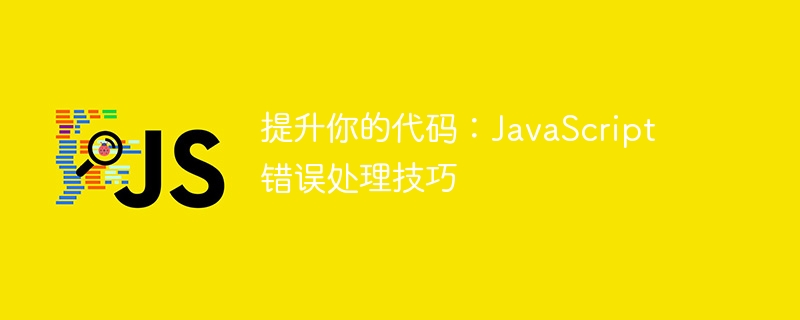Home >Web Front-end >JS Tutorial >Improve your code: JavaScript error handling tips
Improve your code: JavaScript error handling tips
- WBOYWBOYWBOYWBOYWBOYWBOYWBOYWBOYWBOYWBOYWBOYWBOYWBOriginal
- 2024-04-09 12:51:02937browse
JavaScript error handling involves catching and handling unexpected situations that occur while your code is running. Tips include: using try...catch blocks to catch and handle errors; using the throw keyword to actively raise custom errors; accessing the Error object to get error details; inheriting the Error class to create custom error types.

Improving Your Code: JavaScript Error Handling Tips
Understanding Errors
Errors are unexpected situations that occur while a JavaScript program is running. They can be triggered by a variety of factors, such as syntax errors, citation errors, or runtime errors. Understanding error types and their causes is critical to handling them effectively.
Error Handling Tips
Here are some practical tips for handling JavaScript errors:
- try...catch block: Use try. The ..catch block catches and handles errors. If an error is thrown in the try block, control goes to the catch block where the error can be handled and execution can continue.
try {
// 尝试执行代码
} catch (error) {
// 如果发生错误,捕获并处理它
}- throw keyword: Use the throw keyword to actively throw an error. This allows you to create custom errors and provide more details about the error.
throw new Error('自定义错误信息');- Error Object: Whenever an error occurs, an Error object is created. This object contains detailed information about the error, such as error message, line number, and other relevant information.
console.error(error.message); // 打印错误消息 console.error(error.stack); // 打印错误堆栈
- Custom error type: Inheriting the Error class can create your own custom error type. This provides more structured and meaningful error handling.
class ValidationError extends Error {}
throw new ValidationError('验证错误详细信息');Practical Case
The following is an example of using error handling techniques in a practical application:
// 使用 try...catch 块来处理数据转换错误
try {
let number = parseInt('abc');
console.log(number);
} catch (error) {
console.error('非法数据类型');
}In this example, the try block attempts to convert a string into 'abc' is converted to a number. If the conversion is successful, it prints the result. However, since 'abc' is not a valid number, an error is thrown and control goes to the catch block. In the catch block, print an error message indicating that the data type is invalid.
Conclusion
Effective error handling is critical to ensuring the robustness and availability of JavaScript applications. By understanding error types and using geeigneten error handling techniques, you can create more reliable and user-friendly code.
The above is the detailed content of Improve your code: JavaScript error handling tips. For more information, please follow other related articles on the PHP Chinese website!

